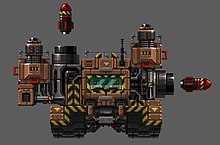
Back نقش متحرك (رسومات الحاسوب) Arabic Sprayt (kompüter qrafikası) Azerbaijani Спрайт (компютърна графика) Bulgarian Sprite (videojocs) Catalan Sprite (počítačová grafika) Czech Sprite (computergrafik) Danish Sprite (Computergrafik) German Sprite (videojuegos) Spanish Sprite-grafiikka Finnish Sprite (jeu vidéo) French

 |
| Part of a series on |
| Video game graphics |
|---|
In computer graphics, a sprite is a two-dimensional bitmap that is integrated into a larger scene, most often in a 2D video game. Originally, the term sprite referred to fixed-sized objects composited together, by hardware, with a background.[1] Use of the term has since become more general.
Systems with hardware sprites include arcade video games of the 1970s and 1980s; game consoles including as the Atari VCS (1977), ColecoVision (1982), Famicom (1983), Genesis/Mega Drive (1988); and home computers such as the TI-99/4 (1979), Atari 8-bit family (1979), Commodore 64 (1982), MSX (1983), Amiga (1985), and X68000 (1987). Hardware varies in the number of sprites supported, the size and colors of each sprite, and special effects such as scaling or reporting pixel-precise overlap.
Hardware composition of sprites occurs as each scan line is prepared for the video output device, such as a cathode-ray tube, without involvement of the main CPU and without the need for a full-screen frame buffer.[1] Sprites can be positioned or altered by setting attributes used during the hardware composition process. The number of sprites which can be displayed per scan line is often lower than the total number of sprites a system supports. For example, the Texas Instruments TMS9918 chip supports 32 sprites, but only four can appear on the same scan line.
The CPUs in modern computers, video game consoles, and mobile devices are fast enough that bitmaps can be drawn into a frame buffer without special hardware assistance. Beyond that, GPUs can render vast numbers of scaled, rotated, antialiased, partially translucent, very high resolution images in parallel with the CPU.
© MMXXIII Rich X Search. We shall prevail. All rights reserved. Rich X Search